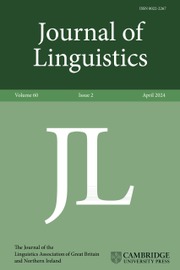Article contents
Left edge topics in Russian and the processing of anaphoric dependencies1
Published online by Cambridge University Press: 04 June 2014
Abstract
This paper investigates the cost of processing syntactic versus extra-syntactic dependencies. The results support the hypothesis that syntactic dependencies require less processing effort than discourse-derived dependencies do (Reuland 2001, 2011; Koornneef 2008). The point is made through the analysis of a novel paradigm in Russian in which a preposed nominal stranding a numeral can show number connectivity (paucal) with a gap following the numeral or can appear in a non-agreeing (plural) form, as in cathedral-paucal/plural, there were three.paucal __. Numerous syntactic diagnostics confirm that when there is number connectivity, the nominal has been fronted via A′-movement, creating a syntactic A′-chain dependency. In the absence of connectivity, the construction involves a hanging topic related via discourse mechanisms to a base-generated null pronoun. The constructions constitute a minimal pair and Reuland's proposals correctly predict that the A′-movement construction will require less processing effort compared to the hanging topic construction. A self-paced reading study for contrasting pairs as in the above example showed a statistically significant slow-down after the gap with the hanging topic as opposed to the moved nominal. We take this to support the claim that a syntactic A′-chain is more easily processed than an anaphoric dependency involving a null pronoun, which must be resolved by discourse-based mechanisms.
Information
- Type
- Research Article
- Information
- Copyright
- Copyright © Cambridge University Press 2014
Footnotes
We are grateful to John Bailyn, Ivano Caponigro, Brian Dillon, Lyn Frazier, Tania Ionin, Ora Matushansky, Barbara Partee, Colin Phillips, Nina Radkevich, Greg Scontras, Irina Sekerina, Yakov Testelets, Ming Xiang, and three anonymous Journal of Linguistics referees for a helpful discussion of this project. We would also like to thank Elena Beshenkova, Vladimir Borschev, Boris Dralyuk, Irina Dubinina, Tania Ionin, Oksana Laleko, Anna Mikhaylova, Elena Muravenko, Alexander Nikolaev, Alfia Rakova, Sol Polinsky, Alex Yanovsky, and Marina Zelenina for their help with Russian judgments. All errors are our responsibility.
The work presented here was supported in part by funding from the Davis Center at Harvard University, the Heritage Language Resource Center at UCLA, and the United States Government to the first author. Any opinions, findings and conclusions or recommendations expressed in this material are those of the authors and do not necessarily reflect the views of any agency or entity of the United States Government.
The following glossing abbreviations are used: coll = collective, part = partitive, pauc = paucal. Other abbreviations follow the Leipzig Glossing Rules.
References
REFERENCES
- 6
- Cited by

